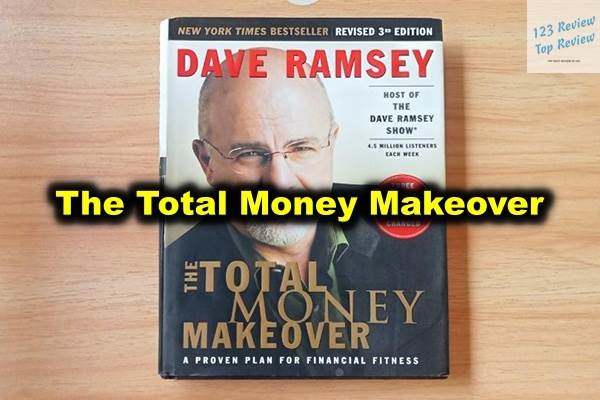In this article, 123 Review delves into the key principles and strategies presented in the book, designed to help readers achieve financial stability and independence. It covers Ramsey’s step-by-step plan for eliminating debt, building savings, and investing wisely. Additionally, the review evaluates the book’s practical advice, its relevance in today’s economic climate, and how it compares to other financial self-help books. Whether you’re a financial novice or looking to fine-tune your money management skills, this review provides valuable insights into how “The Total Money Makeover” can transform your financial life.

Overview of the Total Money Makeover
Author Background
Dave Ramsey, a prominent figure in personal finance, authored “The Total Money Makeover.” Ramsey’s journey began after experiencing bankruptcy in his early years, which drove him to study financial principles and develop a system to help others avoid the pitfalls he encountered. Over the years, Ramsey has become a well-respected financial advisor, radio show host, and best-selling author. His advice combines straightforward, actionable steps with motivational guidance, making complex financial concepts accessible to the average person.
Publication History
“The Total Money Makeover” was first published in 2003 and has since undergone several updates and revisions to remain relevant in a changing economic landscape. The book has sold millions of copies worldwide, establishing itself as a cornerstone of personal finance literature. Its success can be attributed to Ramsey’s ability to demystify financial planning and his charismatic approach to teaching.
Target Audience
The book is aimed at individuals and families looking to take control of their finances, regardless of their current financial situation. Whether someone is drowning in debt, struggling to save, or simply looking to optimize their financial habits, “The Total Money Makeover” provides a clear, actionable plan. It resonates particularly well with those who prefer a disciplined, step-by-step approach to achieving financial health.
The Seven Baby Steps
Step 1: Emergency Fund
The first step in Ramsey’s plan is to save $1,000 as a starter emergency fund. This fund acts as a financial buffer for unexpected expenses, such as car repairs or medical bills, preventing the need to rely on credit cards or loans. Ramsey emphasizes the importance of quickly building this fund to provide immediate financial security and peace of mind.
Step 2: Debt Snowball Method
The Debt Snowball method is one of Ramsey’s most famous strategies. It involves listing all debts from smallest to largest and aggressively paying off the smallest debt first while making minimum payments on the others. Once the smallest debt is eliminated, the freed-up funds are directed towards the next smallest debt, creating a “snowball” effect. This method prioritizes psychological wins, as eliminating smaller debts quickly provides motivation and a sense of accomplishment.
Step 3: Enhance Emergency Fund
After clearing debts, the focus shifts to building a fully-funded emergency fund. Ramsey recommends saving three to six months’ worth of living expenses. This larger emergency fund serves as a robust financial safety net, protecting against significant life events such as job loss or major health issues. Having this fund in place ensures that financial stability is maintained even in the face of substantial emergencies.
Step 4: Retirement Investment
Ramsey advises investing 15% of household income into retirement accounts, such as 401(k)s and IRAs. He stresses the importance of starting early to take advantage of compound interest, which can significantly grow savings over time. Ramsey recommends prioritizing retirement savings to ensure financial security in later years, encouraging investments in diversified, low-cost mutual funds.
Step 5: College Savings
Saving for children’s education is the next priority. Ramsey suggests using tax-advantaged accounts like 529 plans or Education Savings Accounts (ESAs) to build a substantial college fund. By starting early and contributing regularly, parents can alleviate the financial burden of higher education costs and avoid saddling their children with student loan debt.
Key Concepts and Strategies
Importance of Behavioral Change
Ramsey emphasizes that achieving financial success is more about changing behavior than acquiring financial knowledge. He believes that developing disciplined habits, such as consistent saving and mindful spending, is crucial. The book encourages readers to adopt a proactive mindset, setting and adhering to financial goals with determination.
Budgeting and Tracking Expenses
A detailed budget is the cornerstone of Ramsey’s plan. He advocates for the zero-based budget, where every dollar is allocated to a specific purpose, ensuring that money is spent intentionally. By tracking every expense, individuals can gain control over their finances, identify areas of overspending, and make adjustments to align with their financial goals.
Living Debt-Free Philosophy
Central to Ramsey’s approach is the belief that living debt-free is the key to financial freedom. He argues that debt hinders wealth-building efforts and creates financial stress. The book promotes a cash-based lifestyle, where purchases are made using available funds rather than credit. This philosophy encourages readers to live within their means and avoid the pitfalls of consumer debt.
The Role of Emergency Funds
Emergency funds are essential in Ramsey’s strategy, providing a financial buffer that prevents the need to incur debt during crises. The initial $1,000 fund offers immediate protection, while the fully-funded emergency fund ensures long-term financial stability. These funds allow individuals to handle unexpected expenses without derailing their financial plans.
Building Wealth Through Investments
Investing is a key component of Ramsey’s plan. He advocates for long-term growth through retirement accounts and other investment vehicles. Ramsey recommends a balanced approach, focusing on diversified, low-cost mutual funds. By consistently investing a portion of income, individuals can build wealth over time and secure their financial future.
Common Myths Addressed
Myths About Debt
Ramsey debunks the myth that debt is a tool for building wealth. He argues that while some forms of debt may offer short-term benefits, they often lead to long-term financial instability. The book highlights the risks associated with relying on debt and encourages readers to prioritize debt elimination.
Misconceptions of Credit Cards
Ramsey challenges the belief that credit cards are necessary for financial health. He points out that many people misuse credit cards, accumulating high-interest debt. Instead, he promotes a cash-based system where purchases are made with available funds. This approach reduces the risk of overspending and encourages responsible financial behavior.
The Reality of Student Loans
The book addresses the burden of student loans, which can have long-lasting financial impacts. Ramsey offers strategies for minimizing educational debt, such as attending community college, applying for scholarships, and working part-time. He emphasizes the importance of considering the return on investment for higher education expenses.
Home Ownership and Mortgages
While Ramsey acknowledges home ownership as a significant financial goal, he cautions against overextending with mortgages. He advises purchasing a home that is affordable within one’s budget and recommends a 15-year fixed-rate mortgage with a payment that is no more than 25% of take-home pay. This conservative approach ensures that home ownership contributes to financial stability rather than becoming a financial burden.
Quick Fixes vs. Long-term Planning
Ramsey warns against quick fixes and get-rich-quick schemes, advocating for a disciplined, long-term approach to financial health. He emphasizes that true financial success comes from consistent, intentional actions over time rather than from chasing short-term gains. The book encourages readers to focus on sustainable financial practices that build lasting wealth.
Real-Life Success Stories
Testimonials from Individuals
“The Total Money Makeover” features numerous testimonials from individuals who have successfully followed Ramsey’s plan. These stories highlight the transformative impact of the Baby Steps, showcasing how people have paid off significant debts, built emergency funds, and achieved financial freedom. These real-life examples provide motivation and demonstrate the practical application of Ramsey’s principles.
Couples’ Financial Transformations
Couples have found Ramsey’s principles instrumental in aligning their financial goals and improving their relationships. By working together on budgeting, saving, and debt elimination, many couples have strengthened their communication and built a secure future together. The book includes inspiring stories of couples who have overcome financial struggles and achieved shared financial success.
Impact on Families
Families following Ramsey’s plan often experience improved financial stability and reduced stress. The principles of budgeting, saving, and living debt-free can create a positive financial environment for children, teaching them valuable money management skills. The book illustrates how adopting Ramsey’s steps can lead to a more secure and harmonious family life.
Community Initiatives
Ramsey’s teachings have inspired community programs and initiatives that promote financial literacy and well-being. Many churches, schools, and organizations have adopted his principles to help their members achieve better financial health. These community efforts amplify the impact of “The Total Money Makeover,” spreading financial education and empowerment.
Long-term Effects of Adopting the Steps
Adopting Ramsey’s steps has long-term benefits, including financial independence, wealth building, and a legacy of financial literacy. Individuals who follow the plan often find themselves in a position to give back to their communities, support charitable causes, and leave a financial legacy for future generations. The book emphasizes that the principles of disciplined financial management can lead to lasting prosperity.
Critiques and Controversies
Rigidness of the Baby Steps
Some critics argue that the rigidity of Ramsey’s Baby Steps may not suit everyone’s financial situation. They suggest that the plan’s one-size-fits-all approach may require adaptation for individual circumstances. However, Ramsey maintains that the structured nature of the Baby Steps provides clarity and direction, which are essential for achieving financial goals.
Effectiveness of the Debt Snowball
While the Debt Snowball method is praised for its motivational benefits, some financial experts question its efficiency compared to other debt repayment strategies, such as the Debt Avalanche method. The Debt Avalanche focuses on paying off high-interest debts first, potentially saving more money in the long run. Despite this, Ramsey argues that the psychological momentum gained from the Debt Snowball is crucial for sustaining motivation and achieving success.
Personal Finance Education
Ramsey’s approach to personal finance education has been both praised for its simplicity and critiqued for lacking complexity in certain areas. Some experts believe that his advice could be supplemented with more detailed financial education, particularly regarding investment strategies and advanced financial planning. Nevertheless, the book’s straightforward, actionable steps make it accessible to a wide audience, which is one of its greatest strengths.
Ramsey’s Perspective on Credit Use
Ramsey’s strict stance against credit card use and borrowing has sparked debate. While some agree with his philosophy of living debt-free, others argue for a more nuanced approach to credit management. Critics suggest that responsible credit card use can offer benefits, such as building credit history and earning rewards. Ramsey, however, remains firm in his belief that the risks of credit card debt outweigh the potential advantages.
Alternative Approaches to Debt Management
Other financial strategies, such as the Debt Avalanche method and various budgeting techniques, offer alternative approaches to debt management and financial planning. These strategies prompt discussion about the best methods for different financial situations. While Ramsey’s plan may not be the perfect fit for everyone, its emphasis on behavior change, discipline, and long-term planning provides a solid foundation for many seeking financial health.





